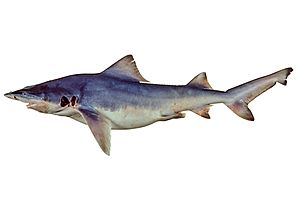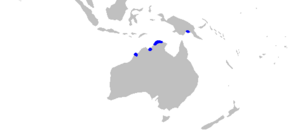Northern river shark facts for kids
Quick facts for kids Northern river shark |
|
|---|---|
 |
|
| Conservation status | |
| Scientific classification | |
| Genus: |
Glyphis
|
| Species: |
garricki
|
 |
|
| Range of the northern river shark | |
The northern river shark or New Guinea river shark (Glyphis garricki) is a type of shark. It belongs to a group called requiem sharks. You can find these sharks in rivers and coastal waters in northern Australia and Papua New Guinea.
These sharks like places where the water is cloudy. They prefer areas with soft, muddy bottoms and strong tides. Young sharks can live in fresh water, salty water, or a mix of both. Adult sharks are usually found in the ocean.
Northern river sharks have a strong, grey body with a high back. They have very small eyes and wide fins. These sharks can grow up to 2.5 m (8.2 ft) long. They mostly eat fish.
Female northern river sharks give birth to live young, usually about 9 babies at a time. They might do this every two years before the wet season starts. This shark is very rare. It faces dangers from fishing and its home being damaged. Because of this, it is listed as critically endangered.
Contents
About the Northern River Shark
The first northern river sharks known to science were two baby males. They were found in Papua New Guinea by a scientist named Jack Garrick. The shark was later named after him.
In 2008, three scientists, Leonard Compagno, William White, and Peter R. Last, officially described the species. The first official shark used for study was a female. She was 67 cm (26 in) long and found in the East Alligator River in Kakadu National Park, Australia.
Where They Live
Northern river sharks have been seen in several places. These include King Sound and the Ord River in Western Australia. They are also found in the Adelaide and Alligator Rivers in Australia's Northern Territory. In Papua New Guinea, they live near Daru and possibly the Fly River.
These sharks live in large rivers, estuaries (where rivers meet the sea), and coastal bays. These places often have cloudy water and muddy bottoms. They also have big tides.
Young sharks can live in fresh water, brackish water (a mix of fresh and salt water), and salty ocean water. Adult sharks have only been found in salty ocean environments.
What They Look Like
The northern river shark has a strong body with a high back. Its head is wide and flat, with a rounded snout. It has tiny eyes that can be covered by a special eyelid.
Its nostrils have a flap of skin that divides them. The mouth is wide and curved. It has many rows of teeth. The upper teeth are triangular and have jagged edges. The lower teeth are narrower and straighter.
The shark's pectoral fins are large and wide. Its pelvic fins are triangular. It has two dorsal fins (fins on its back). The first dorsal fin is tall and triangular. The second dorsal fin is about two-thirds as tall as the first.
The anal fin (underneath) is smaller than the second dorsal fin. The caudal fin (tail fin) has a strong lower part and a long, narrow upper part. The shark's skin is covered in small, overlapping scales called dermal denticles.
This shark is steel-grey on top and white underneath. The line where the colors meet is sharp and jagged. The anal and tail fins can be dark or black at the tips. The biggest northern river shark found was 2.5 m (8.2 ft) long.
Diet and Reproduction
The northern river shark seems to be good at hunting fish in cloudy water. This is because it has slender teeth, small eyes, and many special sensors on its snout. These sensors help it find prey.
Like other requiem sharks, this species gives birth to live young. The baby sharks grow inside the mother. They get food from a special connection, similar to a placenta.
Females usually give birth around October, before the wet season begins. They might have babies every two years. One female shark was found with nine babies inside her.
The baby sharks are born at less than 67 cm (26 in) long. Male sharks become adults when they are between 1.2 and 1.4 m (3.9 and 4.6 ft) long. Females become adults when they are between 1.4 and 1.7 m (4.6 and 5.6 ft) long.
Conservation Status
The northern river shark is very rare. Scientists believe there are fewer than 250 adult sharks left in the wild. In any one area, there might be fewer than 50.
This shark is caught by both commercial fisheries (big fishing businesses) and people fishing for fun. They use longlines and gillnets. Losing their habitat (their natural home) is also a big problem.
Because it is so rare and faces many threats, the IUCN has listed the northern river shark as critically endangered. This means it is at a very high risk of disappearing forever.
It is also listed as endangered in Australia under the Environment Protection and Biodiversity Conservation Act. Kakadu National Park in Australia might be an important safe place for these sharks. However, there are no rules to protect them in Papua New Guinea.
Images for kids
See also
 In Spanish: Tiburón fluvial del norte para niños
In Spanish: Tiburón fluvial del norte para niños




